Optimal Allocation of Intermittent Distributed Generation under Active Management
Abstract
:1. Introduction
2. Uncertainty Modeling of Distributed Generation and Load
2.1. Probabilistic Model of Wind Power
2.2. Probabilistic Model of Photovoltaic Generator
3. Seasonal Scene Reduction
3.1. Improved K-Means Clustering Algorithm
3.1.1. Selection of Calinski–Harabasz Validity Index and Optimal Cluster Number
3.1.2. The Steps of the Improved K-Means Clustering Algorithm
- The search scope for setting the cluster number is [2, ];
- The initial clustering center is selected according to the principle of maximum and minimum distance in the search range. The K-means clustering algorithm is used to update the clustering center until the convergence of the distance criterion function. The index is calculated according to the clustering results. Turn to 2;
- Comparing the index under different k values, the corresponding k value is the best cluster number when the index reaches the maximum value;
- Output best clustering results.
3.2. Seasonal Scene Reduction
4. Bilevel Programming Model of Distributed Generation Based on Multiscenario Analysis under Active Management Mode
- Distributed generator output control;
- Switching of reactive power compensation;
- Adjustment of on load transformer.
4.1. Upper Planning Mathematical Model
- Annual equivalent investment cost of distributed generation:where is the number of nodes in the distribution network, r is the discount rate, y is the life span of DG for 20 years, and are fixed investment costs of unit capacity of wind power and PV installed at the i node, respectively, and are the rated capacity of wind power and PV installed at the i node, respectively.
- Operation and maintenance fee:where is the scenario probability of the n scenario, and are the operation and maintenance costs of the wind power and the photovoltaic unit electricity received by the i node, and and are the wind power received by the i node and the photovoltaic unit electricity generated during the t period of the n typical day, respectively.Distributed generator output control
- Operators purchasing electricity from higher authorities:where is the t time of n typical days to buy electricity from a higher power grid. is the unit cost of operators purchasing electricity from a higher power grid.
- Environmental subsidy:where and are environmental subsidies for unit capacity of wind power generation and environmental subsidies for unit power consumption of photovoltaic units. and are, respectively, the output of wind power and photovoltaic in the i period of the n typical day.
- Loss of net loss:where is the net loss of the n typical day t period, is the unit network loss cost.
- DG installation capacity constraint:where and are the wind capacity and PV capacity node i, respectively. and correspond to the maximum access capacity of DG, respectively.
- DG total installed capacity constraint:where is the maximum installed capacity.
4.2. Lower Level Programming Mathematical Model
- Node power balance constraint:where and are the active output of the t time of the n scenario, respectively. and are the active power of residential and commercial loads at the first time of t in the first n scenario, respectively. and are the reactive power of DG at the t time of the n scenario, respectively. and are the reactive power of resident load reactive power and commercial load at the t time of the n scenario, respectively. is reactive power supplied by reactive power compensation device. and are the voltage amplitude of node i and the voltage amplitude of node j at the t time node of the n scenario, respectively. is the phase difference between node i and node j of t in the n scenario, respectively.
- Node voltage constraint:where is node voltage. and are the minimum voltage values and maximum voltage values allowed by node i, respectively.
- Branch flow constraint:where is the apparent power of branch L. is the limit of branch transmission capacity.
- Distributed generator output control constraint:where and are the minimum active power output of node i and the maximum active power output of distributed generation, respectively.
- Reactive power compensation device constraint:where and are the minimum value of reactive power compensation device of node I and the maximum value of reactive power compensation device.
- Transformer tap constraint:where is the tap position of transformer i. and are the tap values of transformer i and the maximum tap value of i, respectively.
5. Solving Algorithm
5.1. Quantum Evolutionary Algorithm
5.1.1. Qubit Representation
5.1.2. Quantum Genetic Manipulation
5.1.3. QGA Algorithm
- Initialization. The population containing N individuals is where is the individual of the T generation in the population, and there are:where m is the quantum dot number, that is, the length of the quantum chromosome. At the beginning, all , took ;
- According to the value of probability amplitude in , R(t) is constructed. , is a binary string of m length;
- Each individual in R(t) is evaluated by fitness evaluation function, and the optimal individual in this generation is retained. If a satisfactory solution is obtained, the algorithm terminates; otherwise, it is transferred to (4) to continue;
- Update P(t) with appropriate quantum gate U(t);
- Genetic algebra , algorithm to (2) continue.
5.2. Two-Level Model Solving Algorithm
6. Examples and Analysis of Planning Results
6.1. Examples
6.2. Result Analysis
7. Conclusions
Author Contributions
Funding
Conflicts of Interest
Appendix A
| Line Data | |||
|---|---|---|---|
| Access Rd | Branch Impedance/Ω | ||
| First Spot Number | End Point Number | Resistance | Reactance |
| 1 | 2 | 0.922 | 0.047 |
| 2 | 3 | 0.493 | 0.2511 |
| 3 | 4 | 0.366 | 0.1864 |
| 4 | 5 | 0.3811 | 0.1941 |
| 5 | 6 | 0.819 | 0.707 |
| 6 | 7 | 0.1872 | 0.6188 |
| 7 | 8 | 0.7114 | 0.2351 |
| 8 | 9 | 1.03 | 0.74 |
| 9 | 10 | 1.044 | 0.74 |
| 10 | 11 | 0.1966 | 0.065 |
| 11 | 12 | 0.3744 | 0.1238 |
| 12 | 13 | 1.468 | 1.155 |
| 13 | 14 | 0.5416 | 0.7129 |
| 14 | 15 | 0.591 | 0.526 |
| 15 | 16 | 0.7463 | 0.545 |
| 16 | 17 | 1.289 | 1.721 |
| 17 | 18 | 0.732 | 0.574 |
| 2 | 19 | 0.164 | 0.1565 |
| 19 | 20 | 1.5042 | 1.3554 |
| 20 | 21 | 0.4095 | 0.4784 |
| 21 | 22 | 0.7089 | 0.9373 |
| 3 | 23 | 0.4512 | 0.3083 |
| 23 | 24 | 0.898 | 0.7091 |
| 24 | 25 | 0.896 | 0.7011 |
| 6 | 26 | 0.203 | 0.1034 |
| 26 | 27 | 0.2842 | 0.1447 |
| 27 | 28 | 1.059 | 0.9337 |
| 28 | 29 | 0.8042 | 0.7006 |
| 29 | 30 | 0.5075 | 0.2585 |
| 30 | 31 | 0.9744 | 0.963 |
| 31 | 32 | 0.3105 | 0.3619 |
| 32 | 33 | 0.341 | 0.5302 |
References
- Anaya, K.L.; Pollitt, M.G. Going smarter in the connection of distributed generation. Energy Policy 2017, 105, 608–617. [Google Scholar] [CrossRef]
- Mehigan, L.; Deane, J.P.; Gallachoir, B.P.O.; Bertsch, V. A review of the role of distributed generation (DG) in future electricity systems. Energy 2018, 163, 822–836. [Google Scholar] [CrossRef]
- Allan, G.; Eromenko, I.; Gilmartin, M.; Kockar, M.; Mcgregor, P. The economics of distributed energy generation: A literature review. Renew. Sustain. Energy Rev. 2015, 42, 543–556. [Google Scholar] [CrossRef]
- Li, R.; Wang, W.; Xia, M.C. Cooperative planning of active distribution system with renewable energy sources and energy storge systems. IEEE Access 2017, 6, 5916–5926. [Google Scholar] [CrossRef]
- Heidari, S.; Fotuhi-Firuzabad, M.; Kazami, S. Power distribution network expansion planning considering distribution automation. IEEE Trans. Power Syst. 2015, 30, 1261–1269. [Google Scholar] [CrossRef]
- Montoya-Bueno, S.; Mnoza-Hernandez, J.I.; Contreras, J. Uncertainty management of renewable distributed generation. J. Clean. Prod. 2016, 138, 103–118. [Google Scholar] [CrossRef]
- Abbasi, F.; Hosseini, S.M. Optimal DG allocation and sizing in presence of storge systems considering network configuration effects in distribution systems. IET. Gener. Transm. Dis. 2016, 10, 617–624. [Google Scholar] [CrossRef]
- Blanco, R.F.; Dvorkin, Y.; Xu, F.; Wang, Y.; Kirschen, D. Optimal energy storge siting and sizing: A WECC case study. IEEE Trans. Sustain. Energy 2017, 8, 733–743. [Google Scholar] [CrossRef]
- Ziari, I.; Ledwich, G.; Ghosh, A. Optimal allocation and sizing of DGs in distribution network. In Proceedings of the IEEE Power and Energy Society General Meeting, Minneapolis, MN, USA, 25–29 July 2010; pp. 1–8. [Google Scholar]
- El-Sayed, M.A.; Alsaffar, M.A. Two stage methodology for optimal siting and sizing of distributed generation in medium voltage network. In Proceedings of the 2016 IEEE Green Technologies Conference, Kansas City, MO, USA, 6–8 April 2016. [Google Scholar]
- Othman, M.M.; El-Khattam, W.; Hegazy, Y.G.; Abdelaziz, A.Y. Optimal placement and sizing of distributed generators in unbalanced distribution systems using supervised big bang-big crunch method. IEEE Trans. Power Syst. 2015, 30, 911–919. [Google Scholar] [CrossRef]
- Hadian, A.; Haghifam, M.R.; Zohrevand, J.; Akhavan-Rezai, E. Probabilistic approach for renewable DG placement in distribution systems with uncertain and time varying loads. In Proceedings of the 2009 IEEE Power & Energy Society General Meeting, Calgary, AB, Canada, 26–30 July 2009. [Google Scholar]
- Zeng, B.; Zhang, J.H.; Yang, X.; Wang, J.H.; Dong, J.; Zhang, Y.Y. Intergrated planning for transition to low-carbon distribution systems with renewable energy generation and demand response. IEEE Trans. Power Syst. 2014, 29, 1153–1165. [Google Scholar] [CrossRef]
- Thrampoulidis, C.; Bose, S.; Hassibi, B. Optimal placement of distributed energy storge in power networks. IEEE Trans. Autom. Control 2016, 61, 416–429. [Google Scholar] [CrossRef]
- Kaloudas, C.G.; Ochoa, L.F.; Marshall, B.; Majithia, S.; Fletcher, I. Assessing the feature trends of reactive power demand of distribution networks. IEEE Trans. Power Syst. 2017, 32, 4278–4288. [Google Scholar] [CrossRef]
- Zou, K.; Agalgaonkar, A.P.; Muttaqi, K.M. Distribution system planning with incorplorating DG reactive capability and system uncertainties. IEEE Trans. Sustain. Energy 2012, 3, 112–123. [Google Scholar] [CrossRef]
- Shen, X.W.; Shahidehpour, M.; Zhu, S.Z.; Han, Y.D.; Zheng, J.H. Multi-stage planning of active distribution networks considering the co-optimization of operation strategies. IEEE Trans. Smart Grid 2018, 9, 1425–1433. [Google Scholar] [CrossRef]
- Asensio, M.; Munoz-Delgado, G.; Contreras, J. Bi-level approach to distribution network and renewable energy expansion planning considering demand response. IEEE Trans. Power Syst. 2017, 32, 4298–4309. [Google Scholar] [CrossRef]
- Cai, Y.; Lin, J.; Wan, C.; Song, Y.H. Stochastic bi-level trading model for an active distribution company with DGs and interruptible loads. IET Renew. Power Gen. 2017, 11, 278–288. [Google Scholar] [CrossRef]
- Ding, T.; Li, C.; Yan, C.; Li, F.X.; Bie, Z.H. A bilevel optimization model for risk assement and contingency ranking in transmission system reliability evaluation. IEEE Trans. Power Syst. 2017, 32, 3803–3813. [Google Scholar] [CrossRef]
- Zhang, J.T.; Fan, H.; Tang, W. Planning for distributed wind generation under active management mode. Int. J. Electr. Power 2013, 47, 140–146. [Google Scholar] [CrossRef]
- Koutsoukis, N.C.; Georgilakis, P.S.; Hatziargyriou, N.D. Multistage coordinated planning of active distribution networks. IEEE Trans. Power Syst. 2018, 33, 32–34. [Google Scholar] [CrossRef]
- Turitsyn, K.; Sulc, P.; Backhaus, S.; Chertkov, M. Options for control of reactive power by distributed photovoltaic generators. Proc. IEEE 2011, 99, 1063–1073. [Google Scholar] [CrossRef]
- Kane, L.; Ault, G.W. Evaluation of wind power curtailment in active network management schemes. IEEE Trans. Power Syst. 2015, 30, 672–679. [Google Scholar] [CrossRef]
- Anikumar, R.; Devriese, G.; Srivastava, A.K. Voltage and reactive power control to maximize the energy saving in power distribution system with wind energy. IEEE Trans. Ind. Appl. 2018, 54, 656–664. [Google Scholar] [CrossRef]
- Du, E.S.; Zhang, N.; Kang, C.Q.; Kroposki, B.; Huang, H.; Miao, M.; Xia, Q. Managing wind power uncertainty through strategic reserve purchasing. IEEE Trans. Power Syst. 2017, 32, 2547–2559. [Google Scholar] [CrossRef]
- Zhang, S.X.; Cheng, H.Z.; Zhang, L.B. Probabilistic evaluation of available load supply capability for distribution system. IEEE Trans. Power Syst. 2013, 28, 3215–3225. [Google Scholar] [CrossRef]
- Wang, Y.; Zhou, Z.; Botterud, A.; Zhang, K.F. Optimal wind power uncertainty intervals for electricity market operation. IEEE Trans. Sustain. Energy 2018, 9, 199–210. [Google Scholar] [CrossRef]
- Shi, J.; Ding, Z.H.; Lee, W.J.; Yang, Y.P.; Liu, Y.Q.; Zhang, M.M. Hybrid forecasting model for very-short term wind power forecasting based on grey relational analysis and wind speed distribution features. IEEE Trans. Smart Grid 2014, 5, 521–526. [Google Scholar] [CrossRef]
- Soroudi, A.; Afrasiab, M. Binary PSO-based dynamic multi-objective model for distributed generation planning under uncertainty. IET Renew. Power Gen. 2012, 6, 67–78. [Google Scholar] [CrossRef]
- Li, Z.G.; Wu, W.C.; Shahidehpour, M.; Zhang, B. Adaptive Robust Tie-line scheduling considering wind power uncertainty for interconnected power systems. IEEE Trans. Power Syst. 2016, 31, 2701–2713. [Google Scholar] [CrossRef]
- Xu, L.; Ruan, X.; Mao, C. An improved optimal sizing method for wind-solar-battery hybrid power system. IEEE Trans. Sustain. Energy 2013, 4, 774–785. [Google Scholar]
- Wan, C.; Lin, J.; Song, Y.H.; Xu, Z.; Yang, G.Y. Probabilistic forecasting of photovoltaic generation: An efficient statistical approach. IEEE Trans. Power Syst. 2017, 32, 2471–2472. [Google Scholar] [CrossRef]
- Tabone, M.D.; Callaway, D.S. Modeling variability and uncertainty of photovoltaic generation: A hidden state spatial statistical approach. IEEE Trans. Power Syst. 2015, 30, 2965–2973. [Google Scholar] [CrossRef]
- Dvorkin, Y.; Lubin, M.; Backhas, S.; Chertkov, M. Uncertainty set for wind power generation. IEEE Trans. Power Syst. 2016, 31, 3326–3327. [Google Scholar] [CrossRef]
- Xu, X.; Chen, K.; Long, Y. Optimal site selection and capacity determination of multi-types of distributed generation in microgrid considering environment cost and timing characteristics. Power Syst. Technol. 2013, 37, 914–921. [Google Scholar]
- Jia, L.; Li, M.; Zhang, P.; Wu, Y.; Zhu, H.H. SAR image change detection based on multiple kernel K-means clustering with local-neighborhood information. IEEE Geosci. Remote Sens. Lett. 2016, 13, 856–860. [Google Scholar] [CrossRef]
- Ding, M.; XIE, J.L.; Liu, X.Y.; Shi, W.H. The Generation Method and Application of Wind Resources/Load Typical Scenario of Wind Power Grid Integration. Available online: http://kns.cnki.net/KCMS/detail/detail.aspx?dbcode=CJFQ&dbname=CJFDLAST2016&filename=ZGDC201615006&uid=WEEvREcwSlJHSldRa1FhdXNXa0hFbGhTTER1WVFtbkhRV3I2V2RwWkppcz0=$9A4hF_YAuvQ5obgVAqNKPCYcEjKensW4IQMovwHtwkF4VYPoHbKxJw!!&v=MTcyMzk4ZVgxTHV4WVM3RGgxVDNxVHJXTTFGckNVUkxLZmJ1Um1GeUhsVWJyUFB5clBiYkc0SDlmTnFvOUZZb1I= (accessed on 15 July 2018).
- Stegmayer, G.; Milone, D.H.; Kamenetzky, L.; Lopez, M.G.; Carrari, F. A Biologically inspired validity measure for comparison of clustering methods over metabolic data sets. IEEE ACM Trans. Comput. Biol. Bioinform. 2012, 9, 706–716. [Google Scholar] [CrossRef] [PubMed]
- Yao, K.; Gao, J.W. Law of large numbers for uncertain random variables. IEEE Trans. Fuzzy Syst. 2016, 24, 615–621. [Google Scholar] [CrossRef]
- Koutsoukis, N.C.; Siagkas, D.O.; Georigilakis, P.S.; Hatziargyriou, N.D. Online Reconfiguration of Active Distribution Networks for Maximum Integration of Distributed Generation. IEEE Trans. Autom. Sci. Eng. 2016, 14, 437–448. [Google Scholar] [CrossRef]
- Zhang, J.T.; Cheng, H.Z.; Wang, C. Technical and economic impacts of active management on distribution network. Int. J. Electr. Power 2009, 31, 130–138. [Google Scholar] [CrossRef]
- Cheng, Y.F.; Shao, W.; Zhang, S.J.; Li, Y.P. An improved multi-objective genetic algorithm for large planar array thinning. IEEE Trans. Magn. 2016, 52, 1–4. [Google Scholar] [CrossRef]
- Zhu, X.T.; Xiong, J.B.; Liang, Q. Fault Diagnoise of rotation machinery based on support vector machine optimized by Quantum genetic algotithm. IEEE Access 2018, 6, 33583–33588. [Google Scholar] [CrossRef]
- Jin, Z.F.F.; Hou, Z.Q.; Yu, W.S.; Wang, X. Target tracking approach via quantum genetic algorithm. IET Comput. Vis. 2018, 12, 241–251. [Google Scholar] [CrossRef]
- Zhang, L.B.; Lv, H.P.; Tan, D.P.; Xu, F.; Chen, J.L.; Bao, G.J.; Cai, S.B. Adaptive quantum genetic algorithm for task sequence planning of complex assembly systems. Electron. Lett. 2018, 54, 870–872. [Google Scholar] [CrossRef]
- Liu, J.Y.; Wang, H.X.; Sun, Y.Y. Real-coded quantum-inspired gentic algotithm-based BP neural network algorithm. Math. Probl. Eng. 2015, 2015, 1–10. [Google Scholar]
- Paul, T.G.; Hossain, S.J.; Ghosh, S.; Mandal, P.; Kamalasadan, S. A quadratic programming based optimal power and battery dispatch for grid connected microgrid. IEEE Trans. Ind. Appl. 2018, 54, 1793–1805. [Google Scholar] [CrossRef]
- Zhang, S.X.; Chen, K.; Long, Y.; Cheng, H.Z.; Li, K. Distributed wind generator planning based on shuffled frog leaping algorithm. Autom. Electr. Power Syst. 2013, 37, 76–82. [Google Scholar]

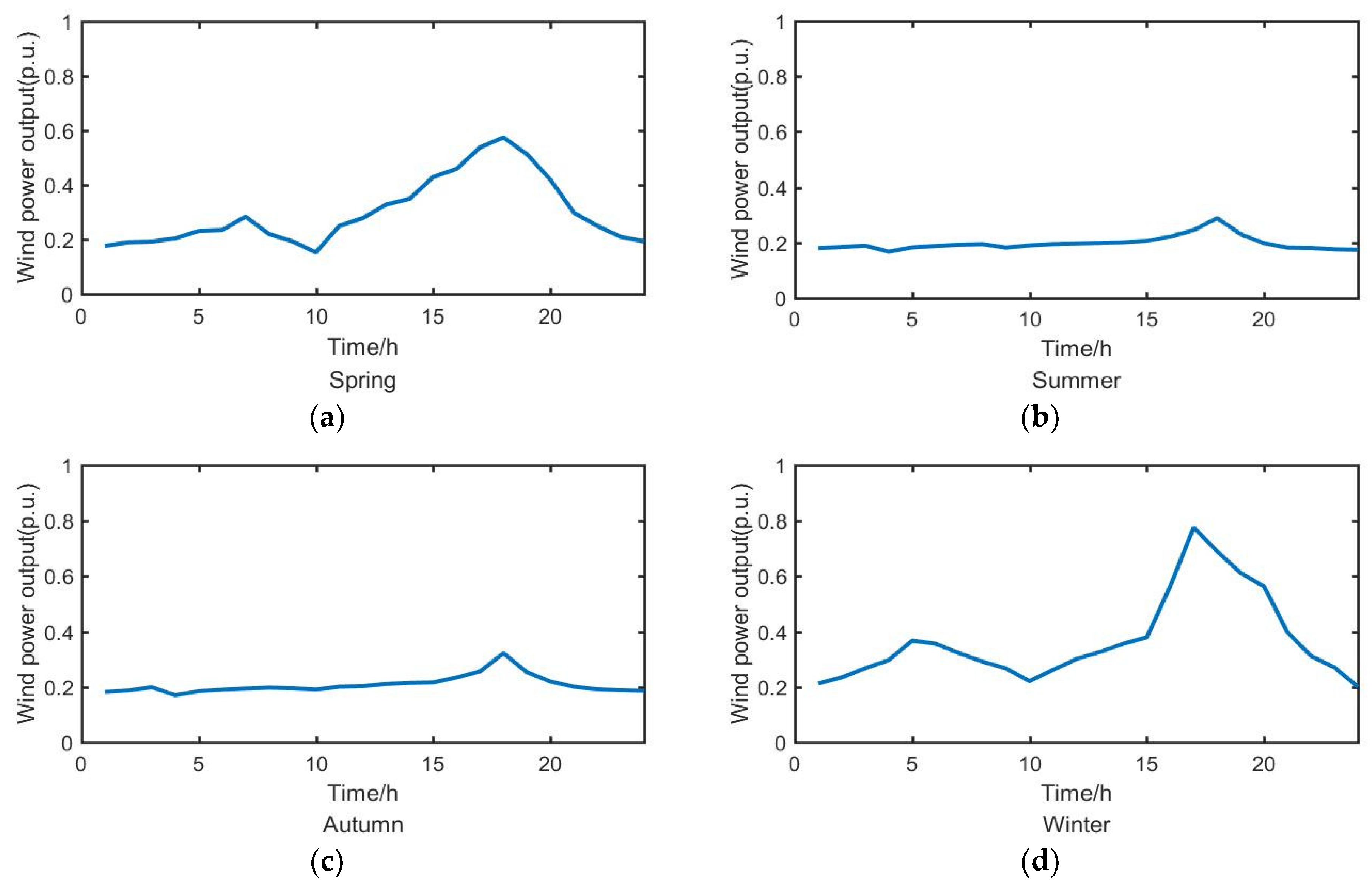
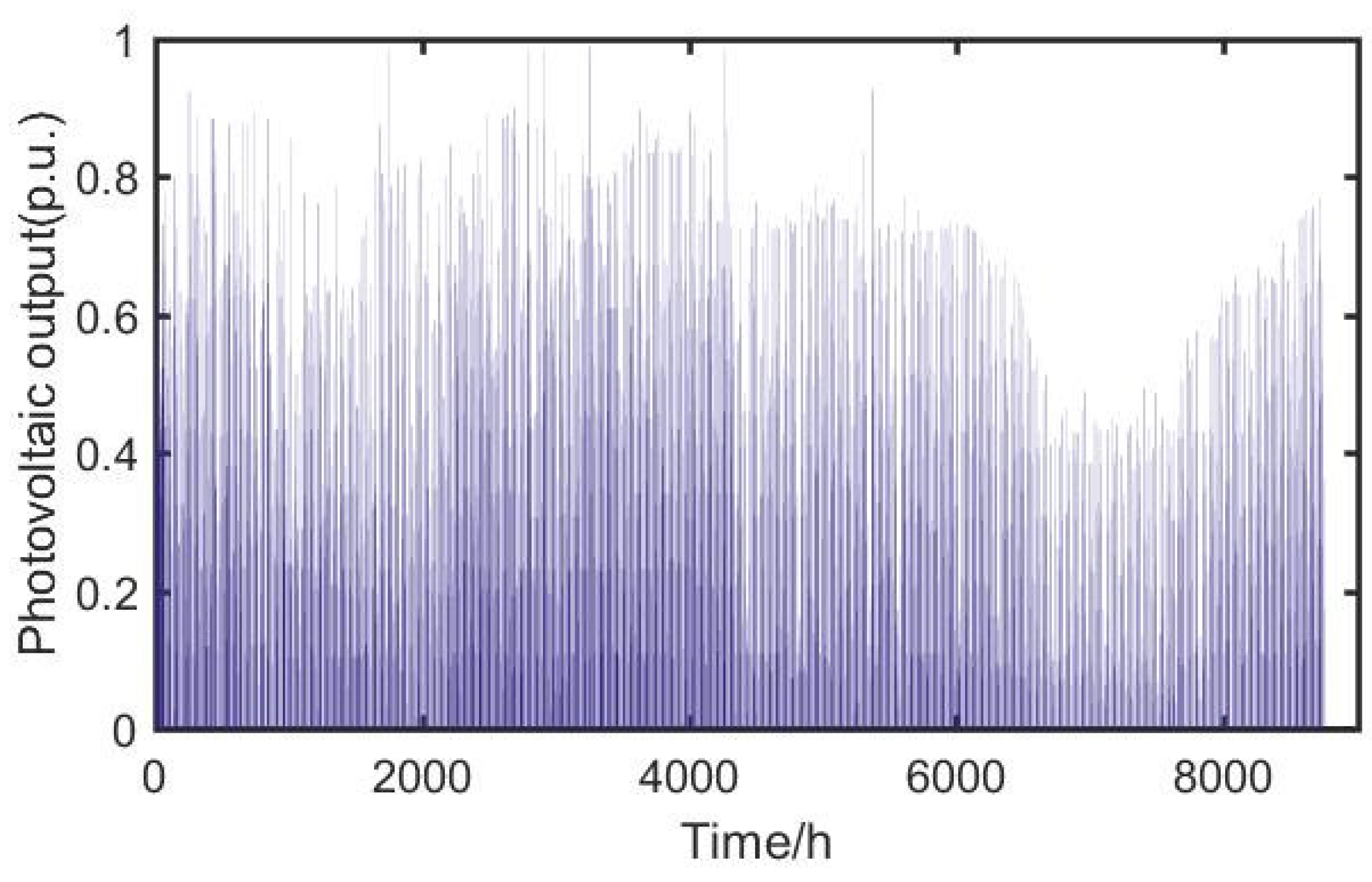



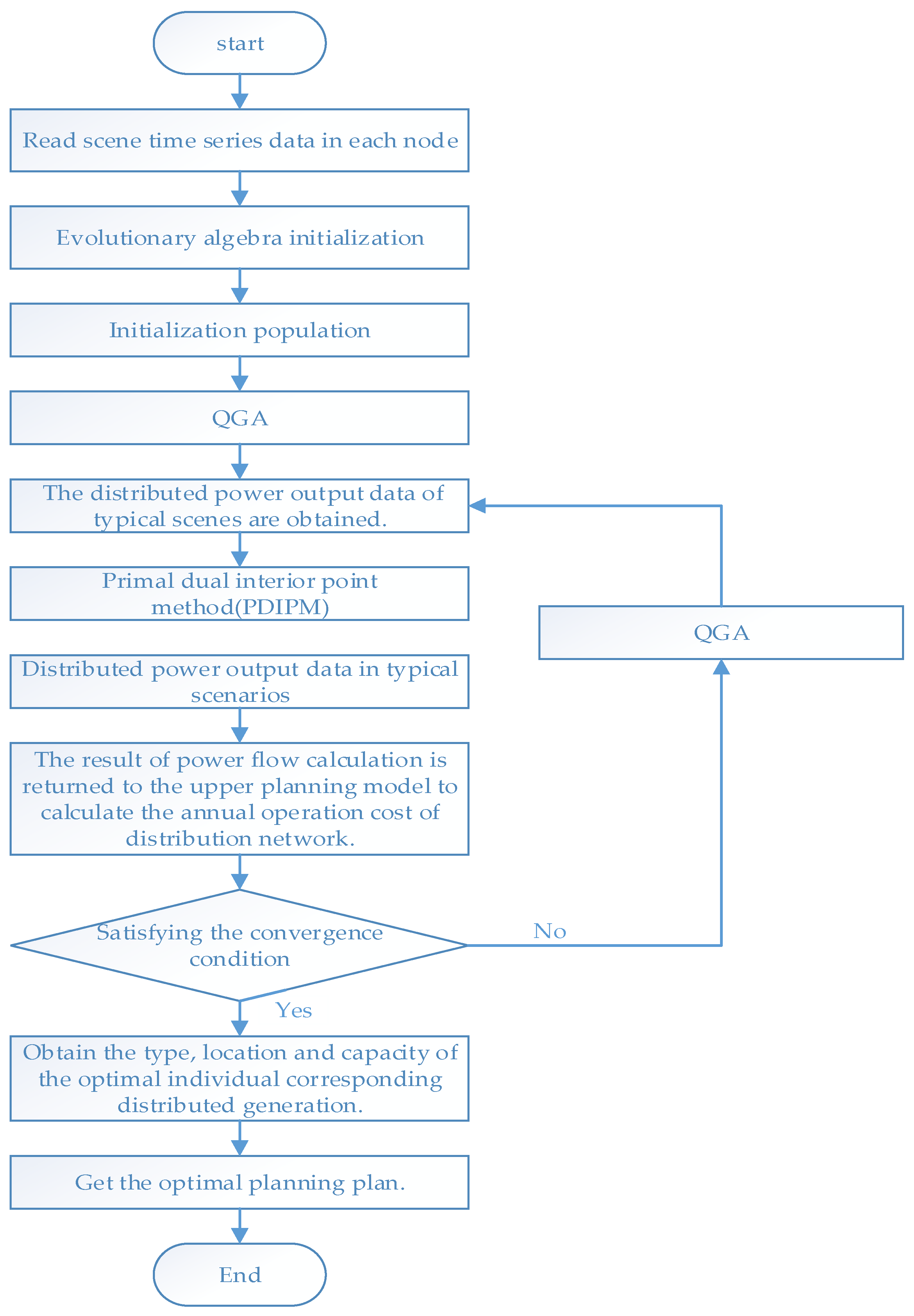
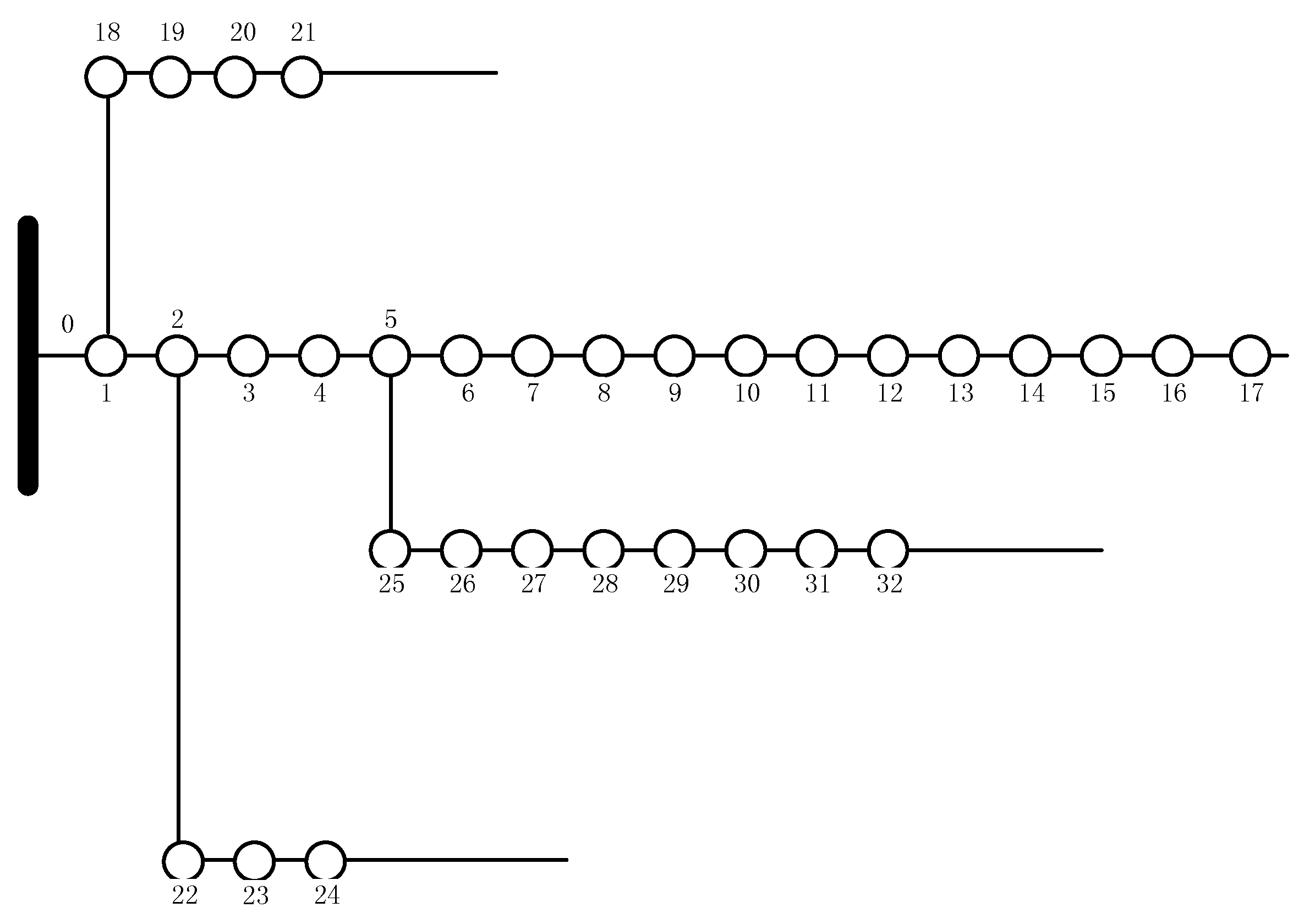
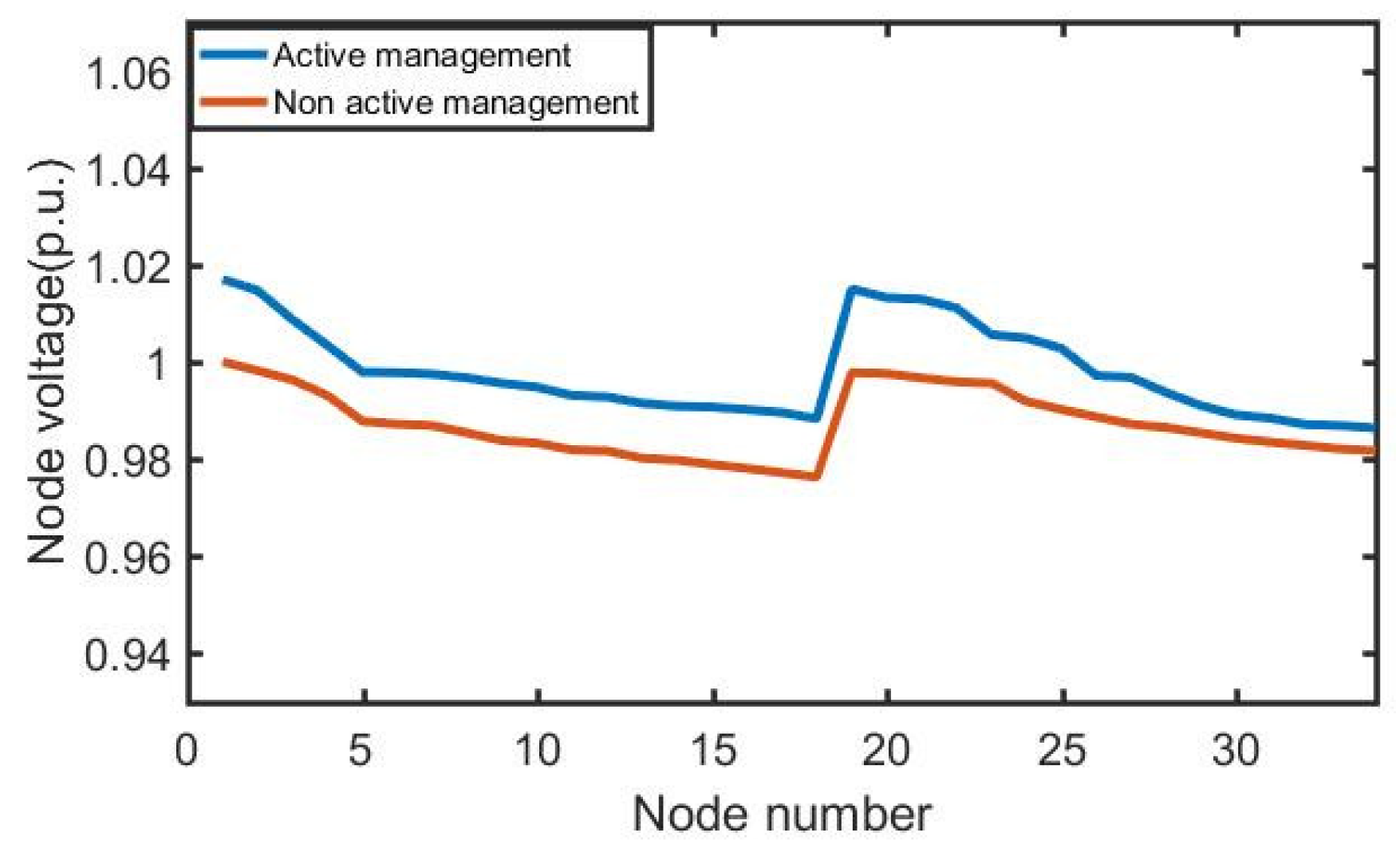
| Season | Weather | ||
|---|---|---|---|
| Sunny | Cloudy | Rainy | |
| Spring | 0.13 | 0.07 | 0.05 |
| Summer | 0.11 | 0.11 | 0.03 |
| Autumn | 0.17 | 0.05 | 0.03 |
| Winter | 0.16 | 0.07 | 0.02 |
| Pattern | DG | Installation Node | Installation Capacity/kW | Investment Cost/¥ | Operation Cost/¥ | Subsidy Cost/¥ | Electricity Purchase Cost/¥ |
|---|---|---|---|---|---|---|---|
| active management mode | WG | 5 | 125 | 1,554,500 | 609,200 | 887,400 | 1,568,800 |
| 7 | 125 | ||||||
| 11 | 375 | ||||||
| 12 | 375 | ||||||
| PV | 20 | 125 | |||||
| 23 | 250 | ||||||
| Non active management mode | WG | 5 | 125 | 1,187,900 | 1,126,400 | 721,900 | 2,001,400 |
| 7 | 250 | ||||||
| 11 | 375 | ||||||
| PV | 20 | 125 | |||||
| 23 | 250 |
| Title 1 | DG Removal Volume in Different Seasons | |||
|---|---|---|---|---|
| Spring | Summer | Autumn | Winter | |
| Active management mode | 11.78 | 1.78 | 7.19 | 13.32 |
| Non active management mode | 42.70 | 12.94 | 26.32 | 45.20 |
© 2018 by the authors. Licensee MDPI, Basel, Switzerland. This article is an open access article distributed under the terms and conditions of the Creative Commons Attribution (CC BY) license (http://creativecommons.org/licenses/by/4.0/).
Share and Cite
Shi, Z.; Wang, Z.; Jin, Y.; Tai, N.; Jiang, X.; Yang, X. Optimal Allocation of Intermittent Distributed Generation under Active Management. Energies 2018, 11, 2608. https://doi.org/10.3390/en11102608
Shi Z, Wang Z, Jin Y, Tai N, Jiang X, Yang X. Optimal Allocation of Intermittent Distributed Generation under Active Management. Energies. 2018; 11(10):2608. https://doi.org/10.3390/en11102608
Chicago/Turabian StyleShi, Zhong, Zhijie Wang, Yue Jin, Nengling Tai, Xiuchen Jiang, and Xiaoyu Yang. 2018. "Optimal Allocation of Intermittent Distributed Generation under Active Management" Energies 11, no. 10: 2608. https://doi.org/10.3390/en11102608
APA StyleShi, Z., Wang, Z., Jin, Y., Tai, N., Jiang, X., & Yang, X. (2018). Optimal Allocation of Intermittent Distributed Generation under Active Management. Energies, 11(10), 2608. https://doi.org/10.3390/en11102608





